Subscribe now to get notified about IU Jharkhand journal updates!
Role of MSME Sector in Providing Fillip to the Entrepreneurship in India
Abstract :
Micro, small and medium enterprises play a pivotal role in the socio-economic development of the country. They are considered as engine of growth. Besides addressing the issues of unemployment and poverty, it assists prodigiously in generating additional family income. Considering the economic significance of MSME sector, Government of India formulated Micro, Small & Medium Enterprises Development Act, 2006 on June 16, 2006, which was notified on October 2, 2006.With the passage of time there has been surge in micro, small and medium enterprises in India, thereby increasing the role of entrepreneurship in MSMEs. MSME sector contributes 29 percent to the GDP and 48 percent to exports. The Government of India envisages a contribution of $2 trillion for micro, small and medium enterprises as India aims to become a $5 trillion economy by 2024. To provide impetus to the growth of MSME sector and to fuel entrepreneurial growth in MSME sector, the government of India has approached multilateral banks like ADB, World Bank and KfW to provide low-cost funds for the sector. It has also planned to launch ‘digital data-based credit ratings’ of MSMEs to assist entrepreneurs in securing bank loans on the basis of these credit ratings.
In view of the significant role of MSME sector in triggering entrepreneurship and fuelling economic growth, it creates substantial academic and research interests to delve deep into the growth of MSMEs in India; schemes of Government of India for encouraging entrepreneurship; role of SME exchange; and performance of MSMEs in India.
Keywords :
Growth of MSMEs in India; Role of MSMEs in stimulating entrepreneurship; Government schemes.1. Introduction
Micro, Small and Medium Enterprises (MSME) sector has emerged as a highly vibrant and dynamic sector of the Indian economy over the last five decades. The MSME also play an important role in the development of the economy with their effective, efficient, flexible and innovative entrepreneurial spirit. The MSME sector contributes notably to the country’s overall industrial production output, employment and exports. It is recognized with generating the maximum employment growth as well as accounting for a major share of industrial production and exports.
They have distinctive advantages due to their size and they required low investment. They have relatively high capital-labor ratio and they require a minimum gestation period. They try to capture and focus smaller markets; they make sure a more fair distribution of national income. They make possible an effective utilization of capital and skill resources and they motivate the growth of industrial entrepreneurship. The MSME sector in India is vast heterogeneous in terms of the size, variety of product and services and level of technology.
This sector is large contributes to the socioeconomic development of the country. The MSME sector is an important pillar of Indian economy as it contributes greatly to growth of Indian economy with a vast network of around 30 million units, creating employment of about 70 million, manufacturing more than 6000 products, contributing about 45% to manufacturing output and about 40% of exports, directly and indirectly. This sector even assumes greater importance now as the country moves towards a faster and inclusive growth agenda.
In the ensuing paragraphs, endeavours will be made to delve deep into various crucial points pertaining to the role of MSME sector in fostering entrepreneurship in India, i.e. growth of micro, small and medium enterprises both in terms of year and registration; growth in micro, small and medium enterprises activity-wise (manufacturing and services);impact of soaring registration of micro, small and medium enterprise on Gross Domestic Product and year wise and social category wise registration of micro, small and medium enterprises across India
Literature Review
Chakarbartty Kuntal (2016) in his research study made critical examination of the contribution of micro, small and medium enterprises (MSMEs) with reference to entrepreneurship development and employment generation in eight states of North East India. In view of introduction of new North East Industrial and Investment Promotion Policy in 2007 with the aim of consolidating and development of MSME sector in North East, the period considered for the research study was 2006-07 to 2012-13. The key observations of the research study was that micro, small and medium enterprises sector contributed immensely in development of entrepreneurship among the youth populace of North East States in India.
Gopalakrishna Gaonkar M (2018) opined that micro, small and medium enterprises (MSMEs) sector has surfaced as a highly vivacious and dynamic sector of the Indian economy and is broadly acclaimed as engine of economic growth, especially with reference to the Make in India initiative of the Government of India. He also mentioned in his research study that MSMEs play a vital role in economic and social development, thereby provding an impetus to entrepreneurship, as they possess intrinsic features of being innovative and responsive to changing market dynamics.
Banerjee Chandrajit (2020) stated that micro, small and medium enterprises (MSMEs) have always played a pivotal role in the socio-economic development of India. Spread across both urban and rural areas, MSMEs produce a diverse spectrum of products and services and offer large scale employment at low capital cost. They not only support in industrialisation of rural and backward areas, but also assist in bringing down regional imbalances and assuring equitable distribution of national income and wealth.
Objective of the study
- To comprehend the growth of micro, small and medium enterprises in India both year wise and registration wise, i.e. thetrend of enterprises registered under micro, small and medium segments.
- To understand as to whether activity-wise, i.e. manufacturing and services, the deviation and variation in registration is higher in case of micro, smallor medium enterprises.
- To comprehend the correlation between the numbers of enterprises registered under micro, small and medium segments and Gross Domestic Product of India.
- To comprehend year wise and social category wise registration of micro, small and medium enterprises.
Research Methodology
1. Linear equation trend: With the assistance of this statistical tool, number of micro, small and medium enterprises that would be registered till 2030 could be ascertained. This statistical tool assist in attaining the first objective of the research study.
2. Standard Deviation and Coefficient of Variation: This statistical tool will assist in comprehending as to under which category of enterprises, i.e. micro, small or medium the deviation and variation is higher. This statistical tool is mapped with the second objective of the research study.
3. Karl Pearson’s Coefficient of Correlation: Through this statistical tool, an endeavour will be made to understand the impact of rising number of micro, small and medium enterprises on a key statistics of Indian economy, i.e. Gross Domestic Product. This statistical tool assist in achieving the third objective of the research study.
4. F-test (One Factor Model): This statistical tool will assist in ascertaining whether there is a significant difference or not in year wise and social category wise registration of micro, small and medium enterprises.
Limitations of the study
1. The study is based on the secondary data.
2. Due to technical constraints all the facets or factors influencing Entrepreneurship in micro, small and medium enterprises could not be studied.
Fostering Entrepreneurship through Growth of MSME
It is to be noted that growth of any sector is gauged on various yardsticks, like the number of enterprises being registered; employment opportunities created; turnover; increase in the number of offshore business units; activity wise, i.e. number of organisations getting registered under manufacturing and service segments etc. In light of the mentioned variables of measuring growth of a sector, in this article, the parameters considered for gauging the growth of MSME sector in India are:
1. Year wise and MSME wise registration.
2. Year wise and major Activity wise registration.
3.Standard deviation and coefficient of variation in the number of enterprises being registered under manufacturing and services segments in MSME sector.
4. Impact of micro, small and medium enterprises on the Gross Domestic Product.
5. Social category wise registration of micro, small and medium enterprises.
1. Year wise and MSME wise registration
The number of registered MSMEs in FY20 has increased by 18.49 per cent to 25.13 lakh units from 21.21 lakh in FY19, according to government data. Overall the number of registered MSMEs in India in the past five years stood at 90.19 lakh. According to the MSME Ministry’s FY19 annual report, the MSME sector is dominated by micro-enterprises. India has 6.33 crore MSMEs out of which 6.30 crore, i.e. 99.4 per cent are micro-enterprises while 0.52 percent, i.e. 3.31 lakh are medium and 0.007 per cent, i.e. 5,000 are medium enterprises.
The growth of MSMEs in India with reference to the year wise and MSME wise registration may be comprehended under the following key points:
- The percentage share of Micro Enterprises registered out of the total MSMEs registered during 2015-16(from Oct., 2015), 2016-17, 2017-18, 2018-19 and 2019-20 (till Dec., 2019) are 85.15%, 90.51%, 88.60%, 88.18% and 87.61% respectively.
- The percentage share of Micro Enterprises registered out of total MSMEsregistered from 2015-16(from Oct., 2015) to 2019-20 (till Dec., 2019) is 88%.
- The percentage share of Small Enterprises registered out of total MSMEs registered during 2015-16(from Oct., 2015), 2016-17, 2017-18, 2018-19 and 2019-20 (till Dec., 2019) are 14.31%, 9.12%, 10.95%, 11.36% and 11.92% respectively.
- The percentage share of Medium Enterprises in the MSMEs during 2015-16 (from Oct., 2015), 2016-17, 2017-18, 2018-19 and 2019-20 (till Dec., 2019) are 0.53%, 0.36%, 0.43%, 0.44% and 0.46% respectively.
- Maharashtra tops the list of number of Micro, Small & Medium Enterprises registrations during 2015-16(from Oct., 2015) to 2019-20 (till Dec., 2019).
Please refer exhibit 1 for year wise and MSME wise registration
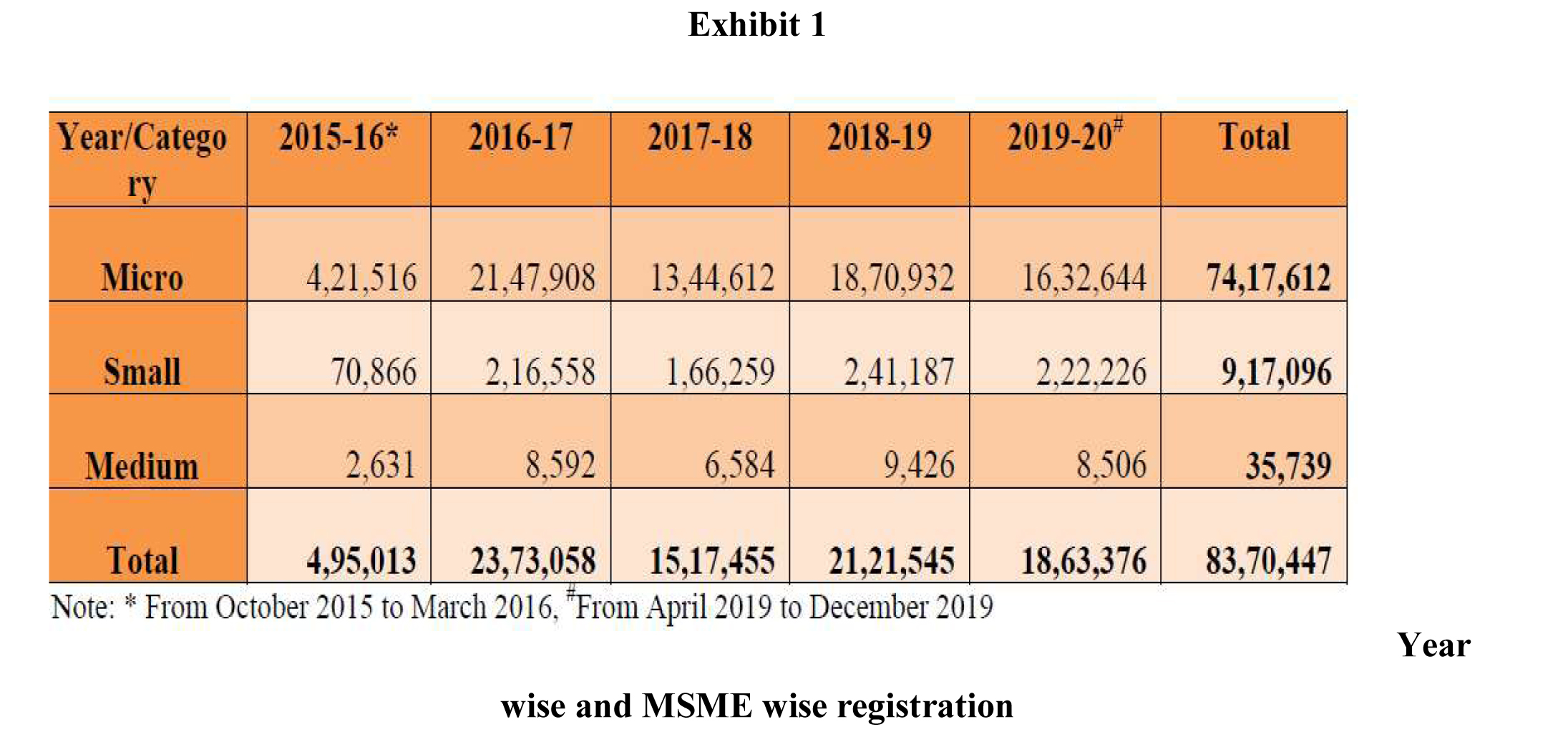
Source: dcmsme.gov.in
Now it will be of substantial academic and research interests to ascertain the trend of MSMEs getting registered under the three categories, i.e. Micro, Small and Medium. In this regard, a prognosis of enterprises that may be registered under the mentioned categories till 2030 have been undertaken with the help of the statistical tool called linear equation trend.
Linear equation trend is: y = bx + a
Where:
- b is the slope of a trendline.
- a is the y-intercept, which is the expected mean value of y when all x variables are equal to 0. On a chart, it's the point where the trendline crosses the y axis.
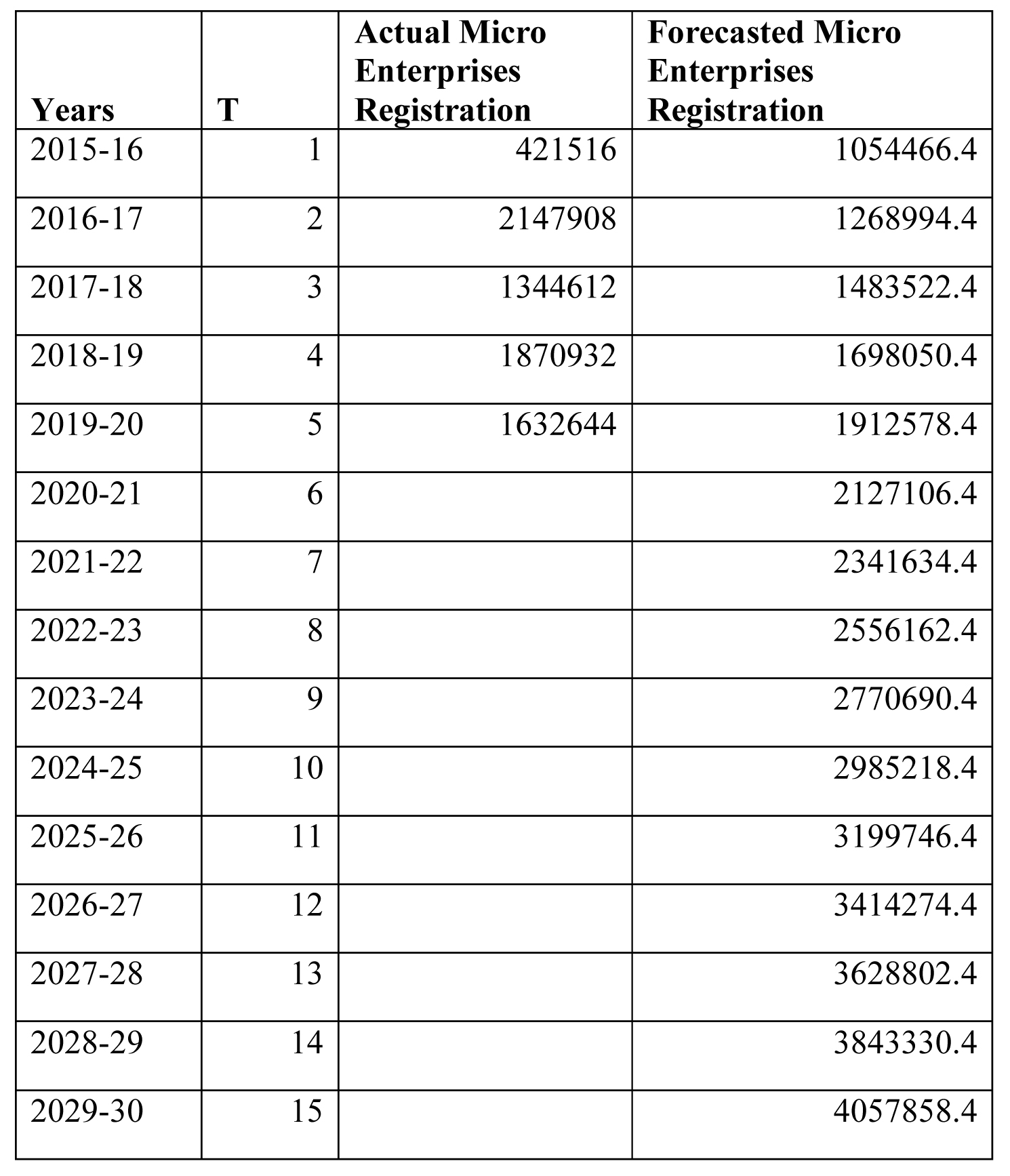
The forecasted trend of registration of Micro Enterprises under MSME sector till 2030 is presented in the exhibit 2
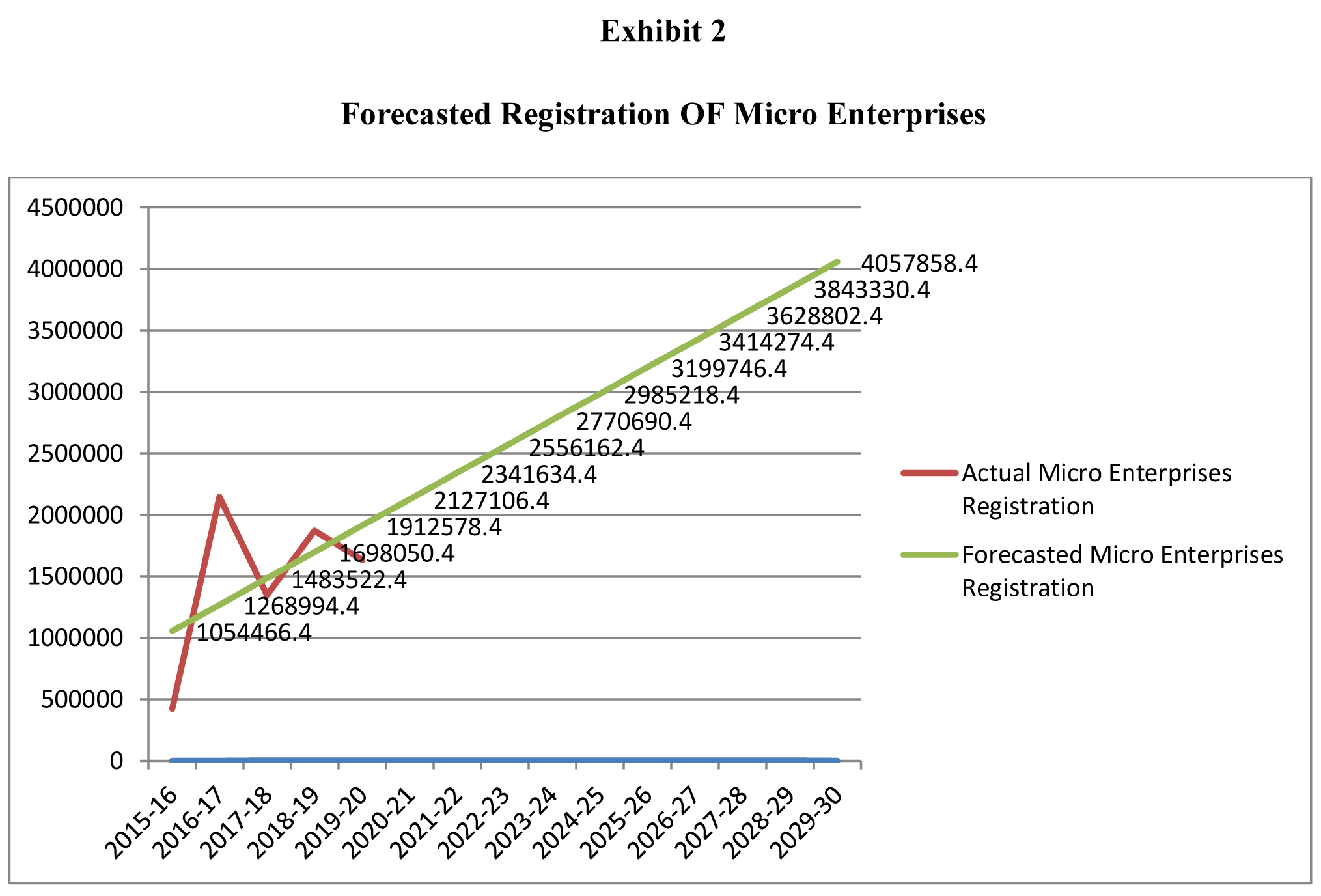
ii) Forecasted value of Registration of Enterprises under Small Segment of MSME Sector
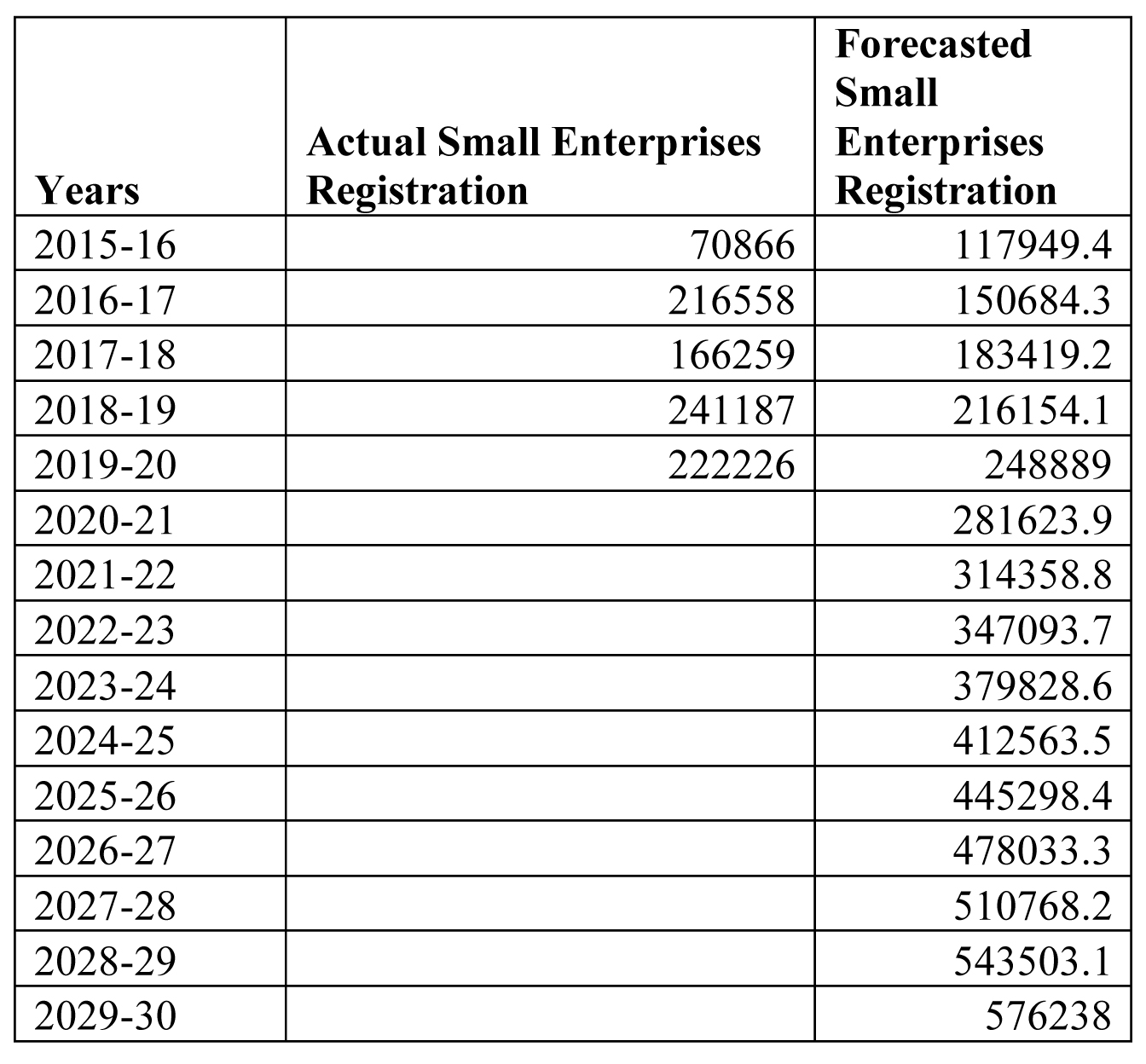
The forecasted trend of registration of Small Enterprises under MSME sector till 2030 is presented in the exhibit 3
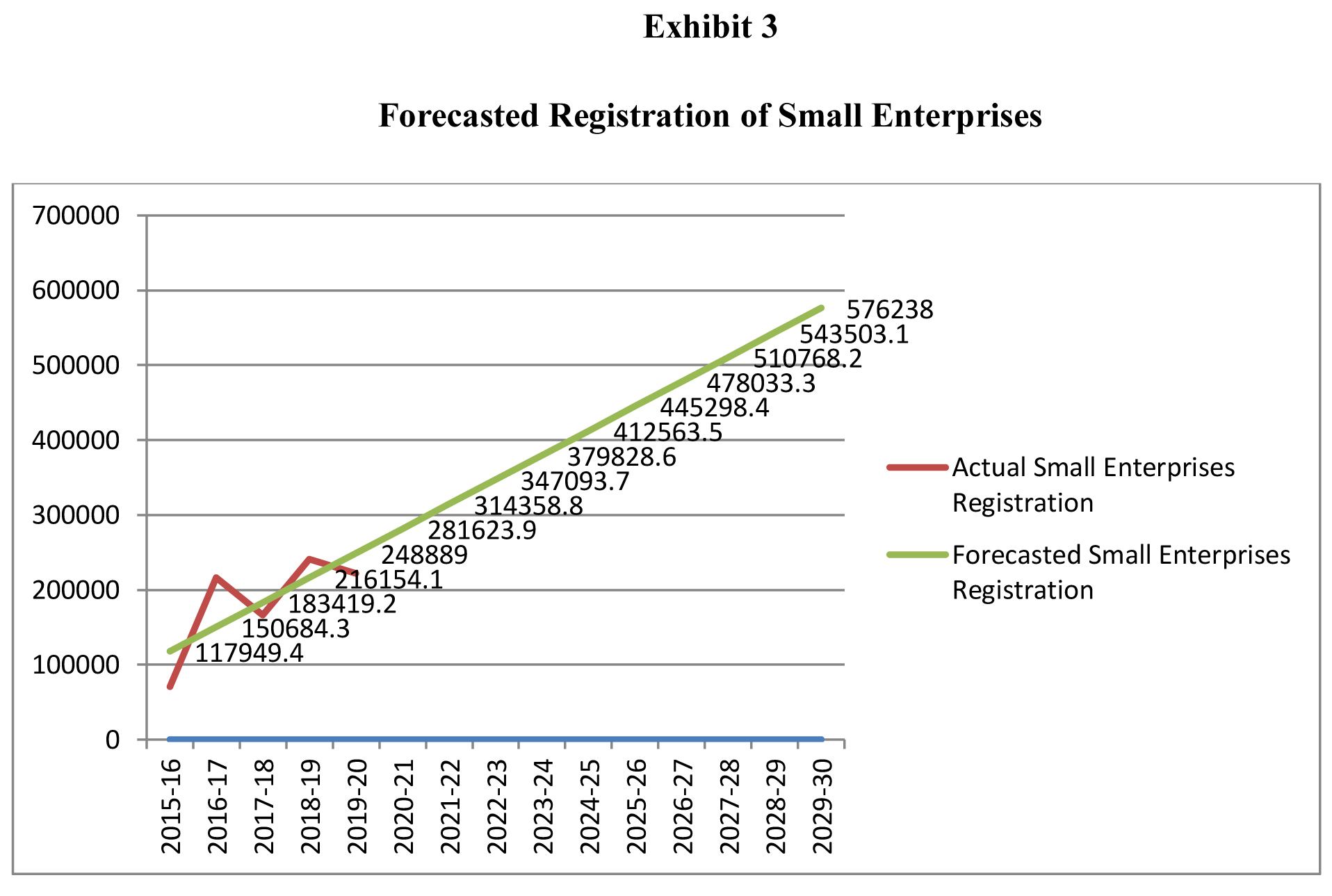
iii)Forecasted value of Registration of Enterprises under Medium Segment of MSME Sector
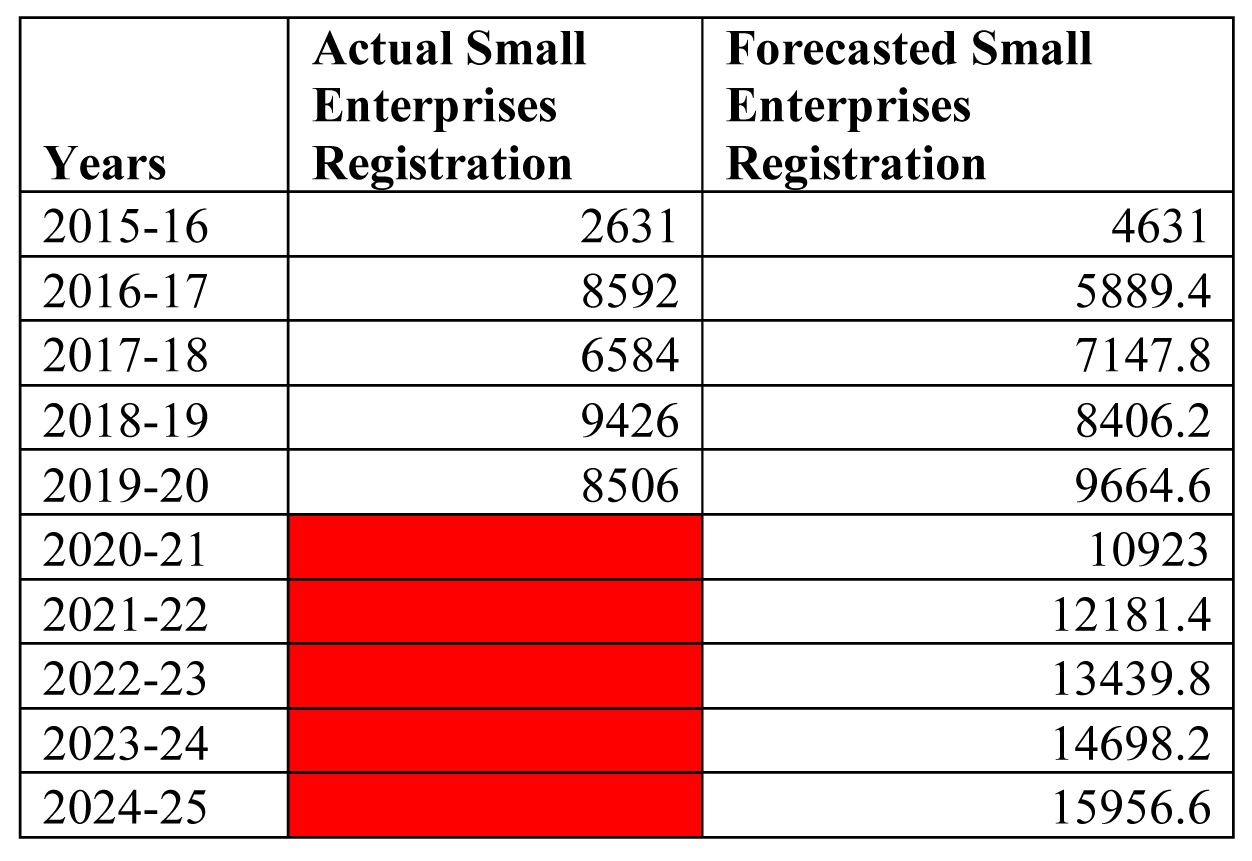

The forecasted trend of registration of Medium Enterprises under MSME sector till 2030 is presented in the exhibit 4

Thus, it is heartening to note from the linear trend that all the three segements of MSME, i.e. micro, small and medium enterprises are going to grow exponentially in the years to come, thereby creating mammoth employment opportunities and contribute substantially to the Gross Domestic Product.
If the above mentioned linear equation trends for micro, small and medium enterprises becomes reality, then it would be good news for large scale industries too, as numerous micro, small and medium enterprises manufacture ancillary products for the finished goods provided by the large scale industries. Next, with the growth in number of MSMEs, there is high probability of meteoric rise in exports from India and reduction of dependence on imports, thereby improving the balance of trade scenario.
Moreover, in a recent development wherein, the limits for investment in plant and machinery has been revised and concept of turnover has been ensconced will definitely act as a boon for the MSME sector in view of the rising trends.
2. Year wise and Major Activity wise registration.
The growth of MSMEs in India with reference to the year wise and Activity wise registration of MSMEs may be comprehended under the following key points:
1. During 2015-16 (Oct., 2015) to 2019-20 (till Dec., 2019) 41% MSMEs engaged in Manufacturing activities while 59% MSMEs engaged in the Service activities.
2. During 2015-16 (Oct., 2015) to 2019-20 (till Dec., 2019) 40.61% and 59.38% Micro Enterprises are engaged in the Manufacturing and Service activities respectively.
3. During 2015-16 (Oct., 2015) to 2019-20 (till Dec., 2019) 45.43% and 54.56% Small Enterprises are engaged in the Manufacturing and Service activities respectively.
4. During 2015-16 (Oct., 2015) to 2019-20 (till Dec ., 2019) 56.77% and 42.22% Medium Enterprises are engaged in the Manufacturing and Service activities respectively.
Please refer exhibit 5 for year wise and major activity wise registration.
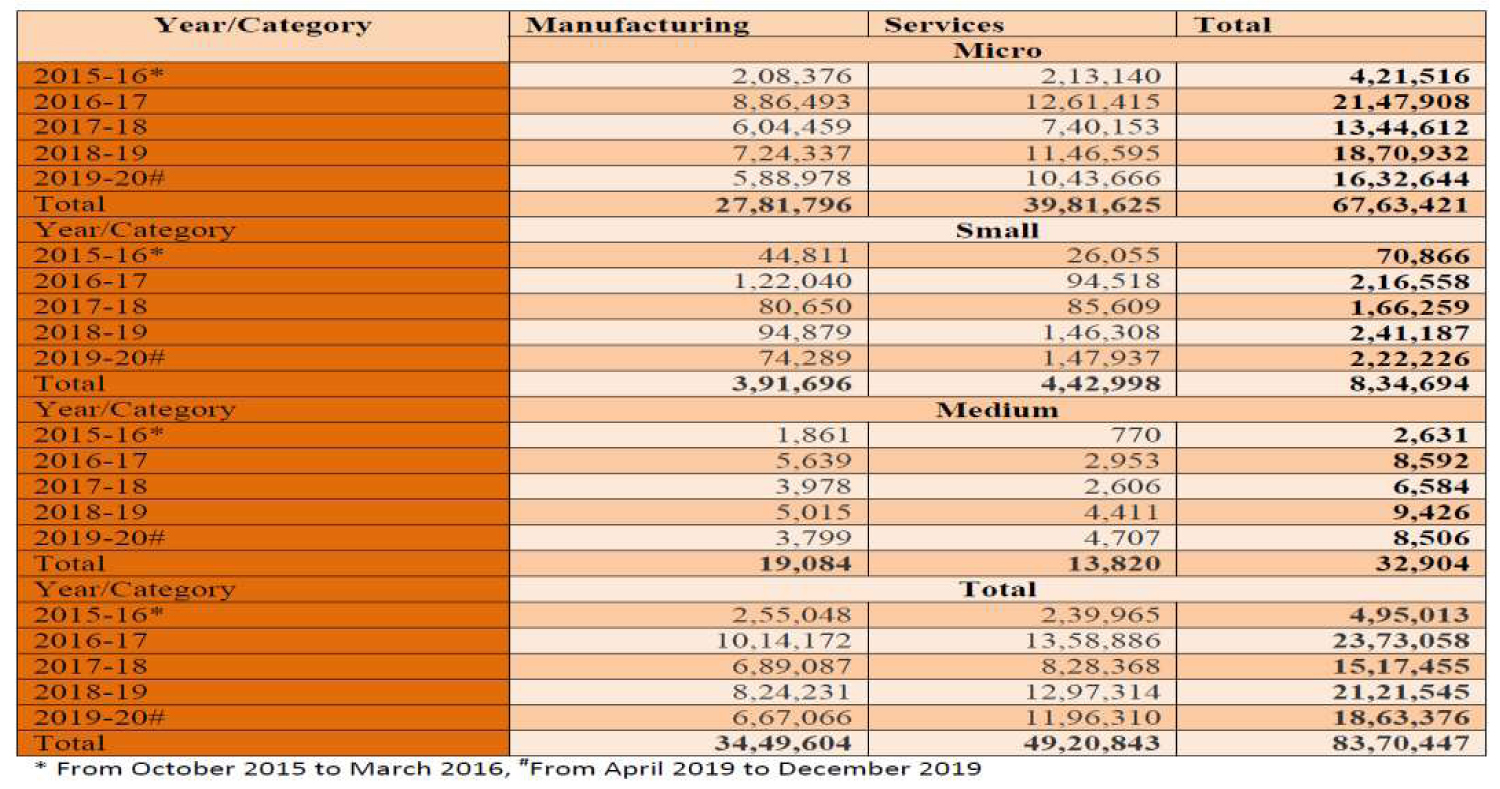
Source: dcmsme.gov.in
At this juncture, it would be interesting to observe whether the deviation as well as variation in registration of enterprises under MSME sector is higher in case of Micro, Small or Medium. In order to observe the deviation and variation in registration of MSMEs, the univariate statistical tool of Standard Deviation and Coefficient of Variation have been applied.
i) Standard Deviation and Coefficient Variation in Registration of Enterprises under Micro Segment of MSME Sector
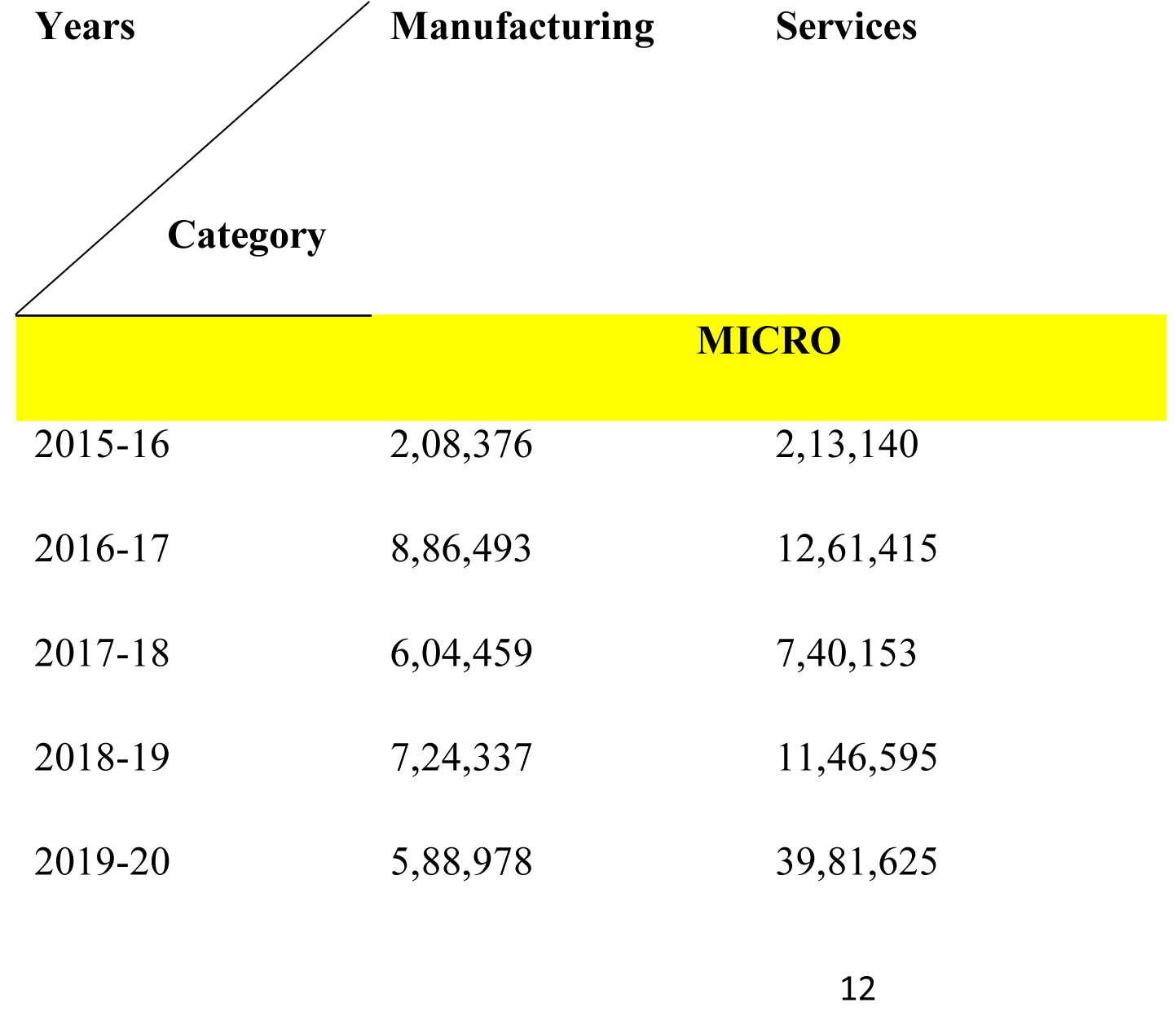
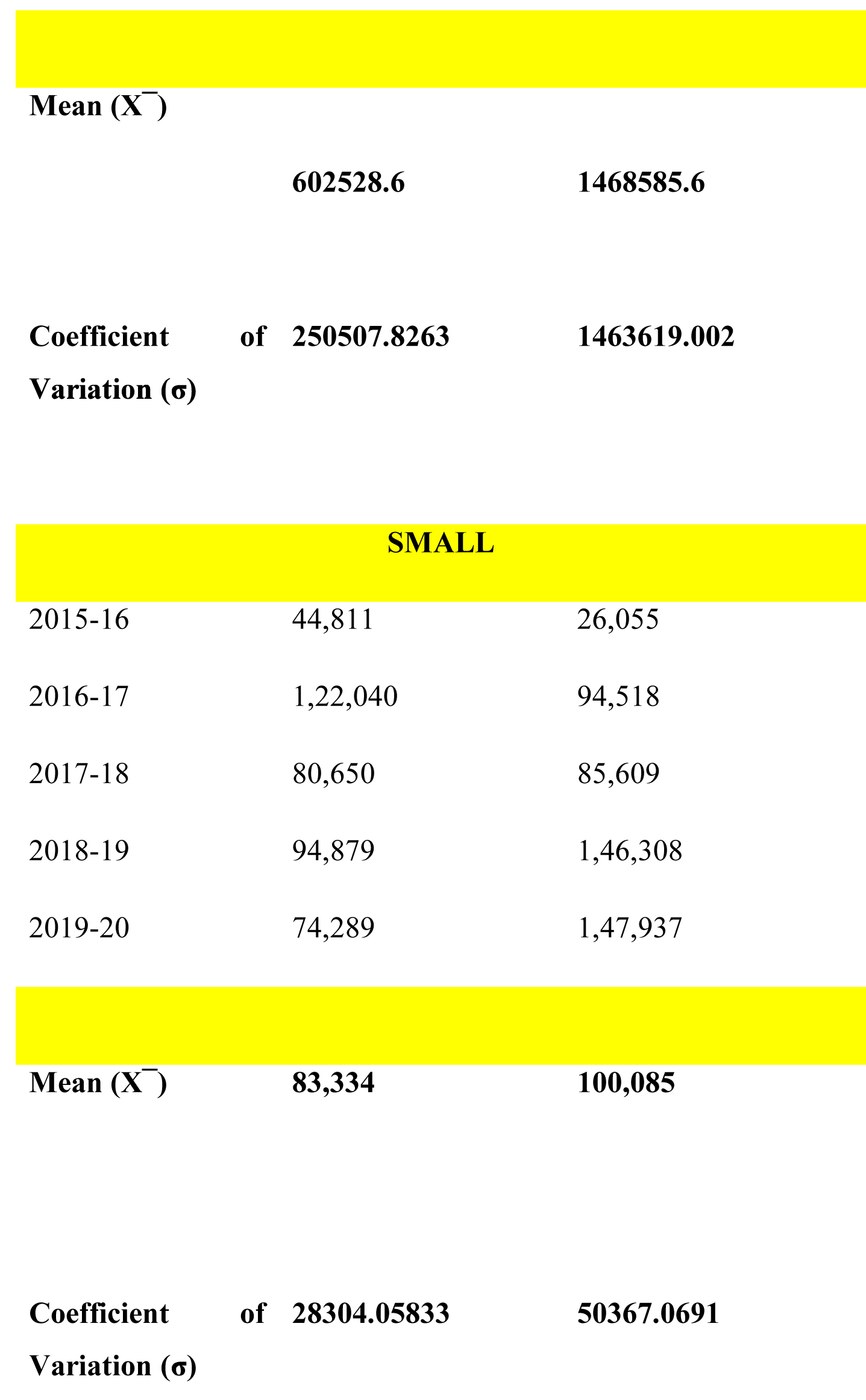
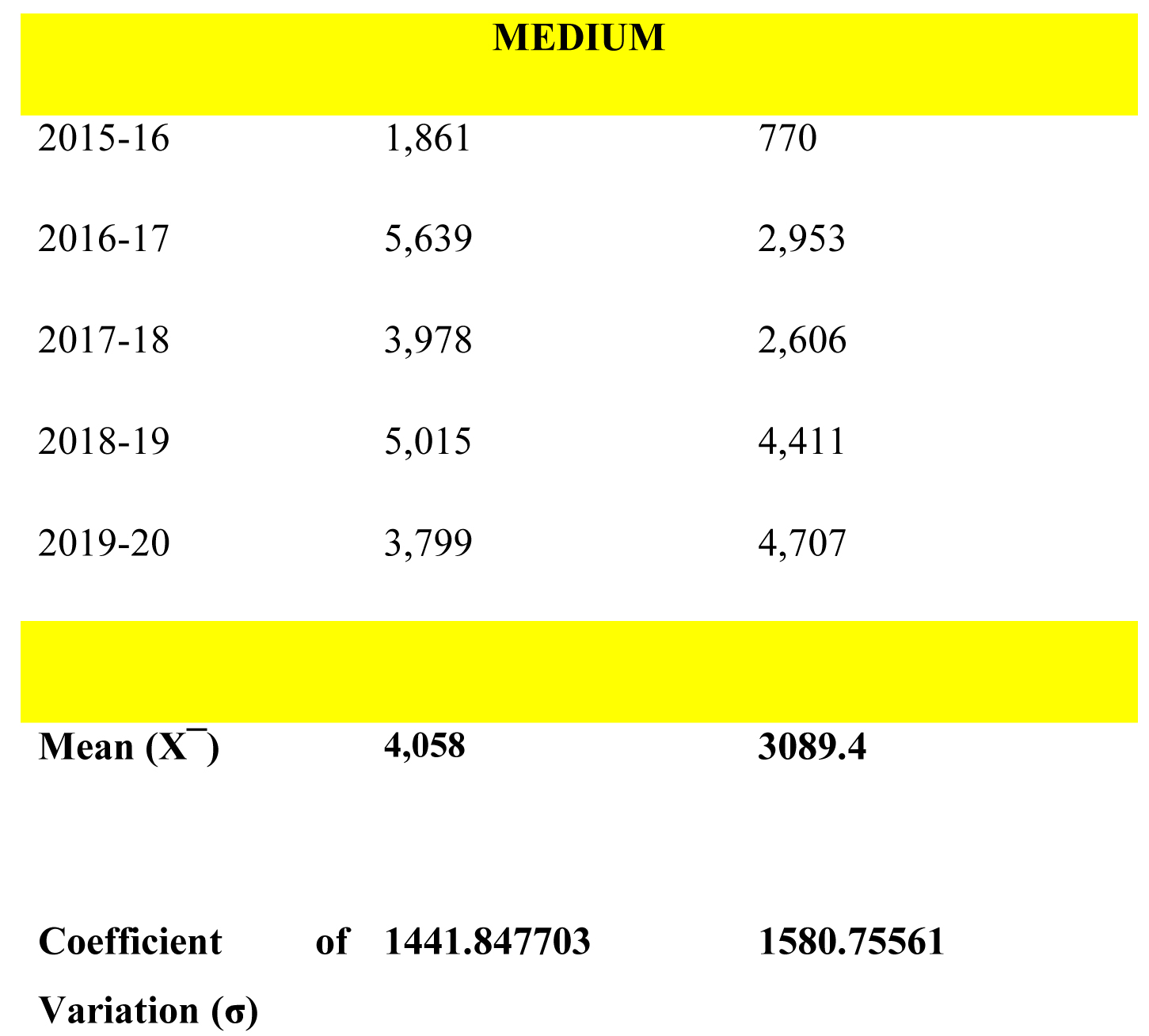
From the above analysis it may be observed that deviation in the registration of enterprises under manufacturing and services segments of Micro category is comparatively higher than the Small enterprises segment. Similarly, the coefficient of variation is also higher for the enterprises (manufacturing and services) registered under Micro category, signifying high variability in the data series, i.e. variability in the number of enterprises registered under both manufacturing and services segments are higher.
It is to be noted that as per the above analysis no doubt both standard deviation and coefficient of variation values are the lowest for the enterprises registered under Medium segment, but since the number of enterprises as a whole registered under manufacturing and services segments under the Medium segment is far less than the Micro and Small, so inferring that it has the lowest standard deviation and coefficient of variation may not provide an appropriate picture.
It would be interesting to note the correlation between two significant variables, i.e. Registration of MSMEs and a vital statistics, i.e. Gross Domestic Product to comprehend as to whether with the rise in registration of enterprises in the MSME sector does it has exerted a robust impact on the national income of India or not. Another critical observation would be that how rising entrepreneurship in the MSME sector, as higher registration of MSMEs is an indication of entrepreneurship mushrooming in the MSME sector on the national income.
Karl Pearson’s Coefficient of Correlation has been used to study the above mentioned fact and the period considered for the study is from 2015-16 to 2019-20. Registration of MSMEs and National Income during the mentioned period has been considered as the independent variable and dependent variable respectively.
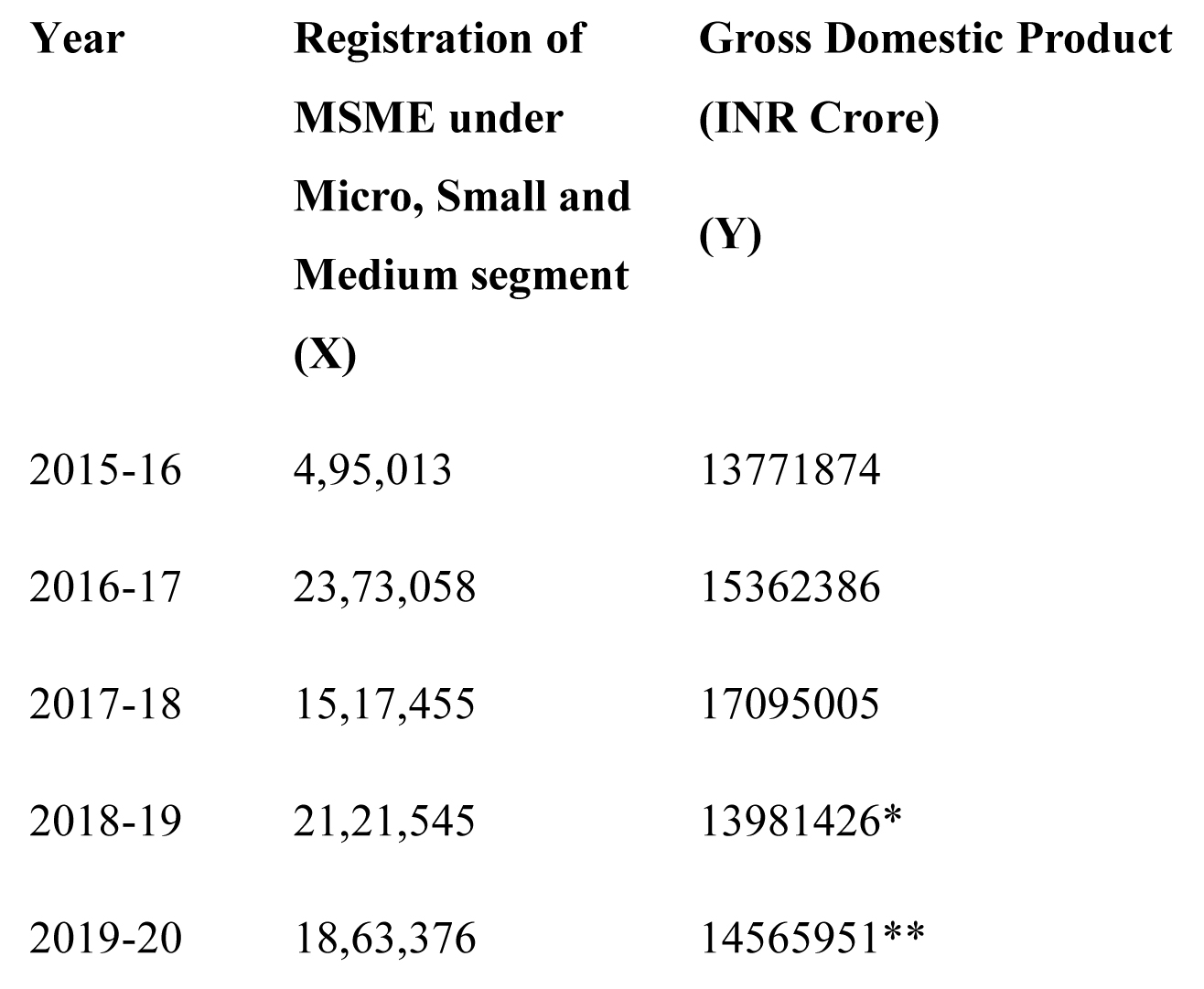 * 1st Revised Estimates
* 1st Revised Estimates
** Provisional Estimates
Note: Gross Domestic Product data has been accessed from the Ministry of Statistics and Programme Implementation
Thus, by applying Karl Pearson’s Coeffieince of Correlation through MS-Excel the value of
r = Σdxdy /√Σdx2 Σdy2
= 0.212168552
Coefficient of determination (r²) = 0.424337105
Coefficient of non-determination (k²) = 1- r² = 1 – Explained Variance / Total Variance
= 1 – 0.424337105 = 0.575662895
Thus, it may be inferred from the above analysis that there is extremely weak correlation between registration of MSMEs and gross domestic product. Further, from the co-efficient of determination also, it may be opined that the variation in the dependent variable, i.e. gross domestic product is largely explained by other factors than the independent variable considered for the analysis, i.e. registration of MSMEs.
At this juncture, it would be of substantial academic and research interests to find out whether there is a significant difference or not in the entrepreneurship social category wise in the MSME sector. In order to analyse the mentioned point, F-test (One Factor Model) has been used.
F-test (One Factor Model)
Null Hypothesis (H0): There is no significant difference in the entrepreneurship social category wise in the MSME sector on the basis of the MSME registered under SC, ST, OBC and General category.
Alternative Hypothesis (H1):There is a significant difference in the entrepreneurship social category wise in the MSME sector on the basis of the MSME registered under SC, ST, OBC and General category.
Applying F-test (One Factor Model) through MS-Excel we get the following:
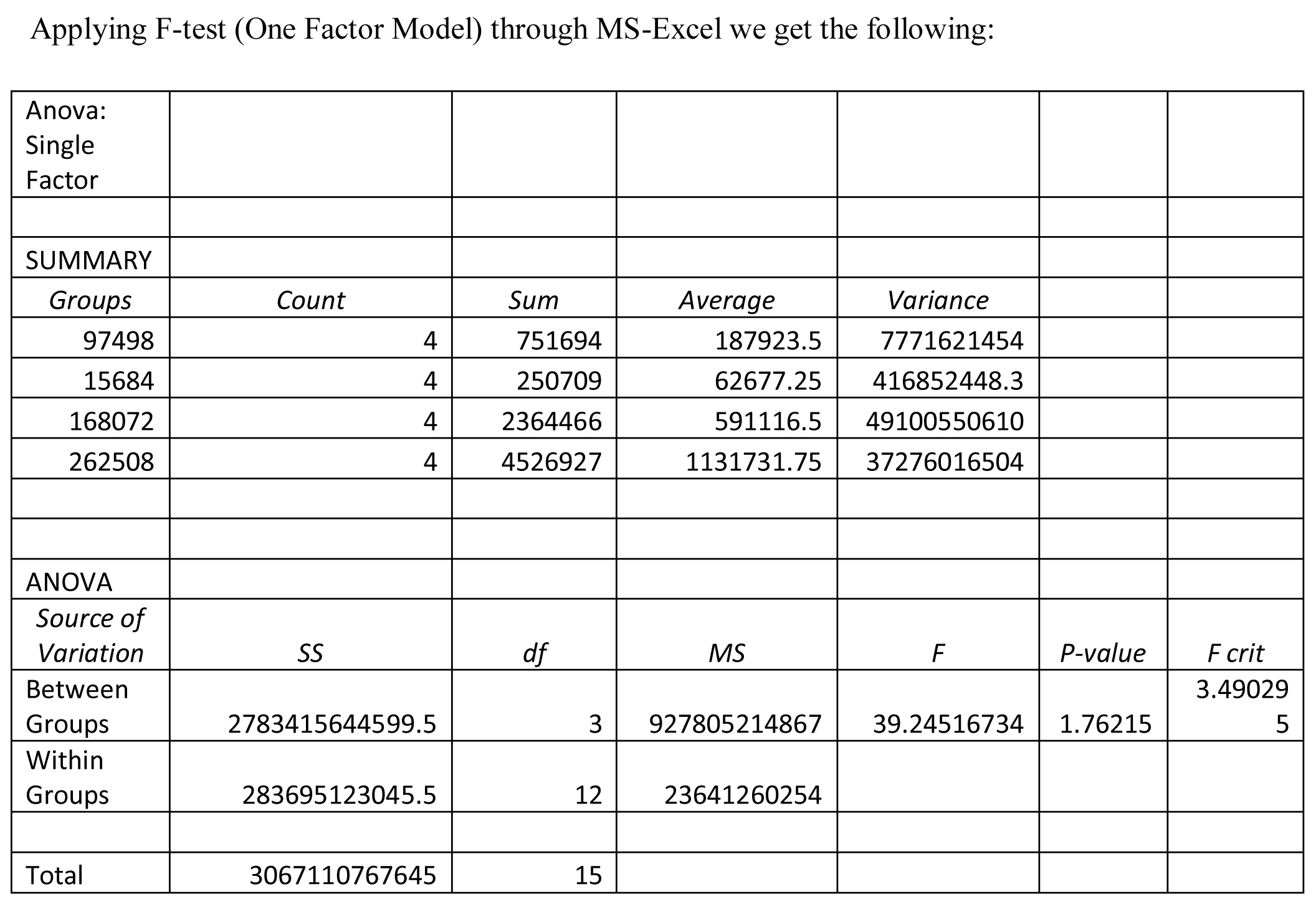
Decision: Since P-value, i.e. 1.76215 is more than significance level, i.e. 0.05, so null hypothesis is accepted and it may be inferred that there is no significant difference in the entrepreneurship social category wise in the MSME sector on the basis of the MSME registered under SC, ST, OBC and General category.
Revised Classification of Micro, Small and Medium Enterprises
The Ministry of Micro, Small and Medium Enteprises has revised classification of Micro, Small and Medium Enteprises with effect from 1st July, 2020. The revised criteria with reference to the investment in plant and machinery / equipment and annual turnover for MSMEs are as under:
1. Investment in Plant and Machinery or Equipment (Micro enterprise): Not more than Rs.1 crore and Annual Turnover ; not more than Rs. 5 crore.
2. Investment in Plant and Machinery or Equipment (Small enterprise):Not more than Rs.10 crore and Annual Turnover ; not more than Rs. 50 crore.
3. Investment in Plant and Machinery or Equipment (Medium enterprise): Not more than fifty crore rupees and turnover does not exceed two hundred and fifty crore rupees.
The aforesaid announcement was made under Atma-nirbhar Bharat Abhiyaan Economic Package to assuage India’s economic predicament amidst the pandemic. According to the Ministry of MSME the new definition will pave way for strengthening and growth of the MSMEs. Particularly, the provision of excluding the exports from counting of turnover will encourage the MSMEs to export more and more without fearing to loose the benefits of a MSME unit. This is expected to exponentially add to exports from the country leading to more growth and economic activity and creation of jobs. The previous and revised definition of MSMEs is provided in the exhibit 6.
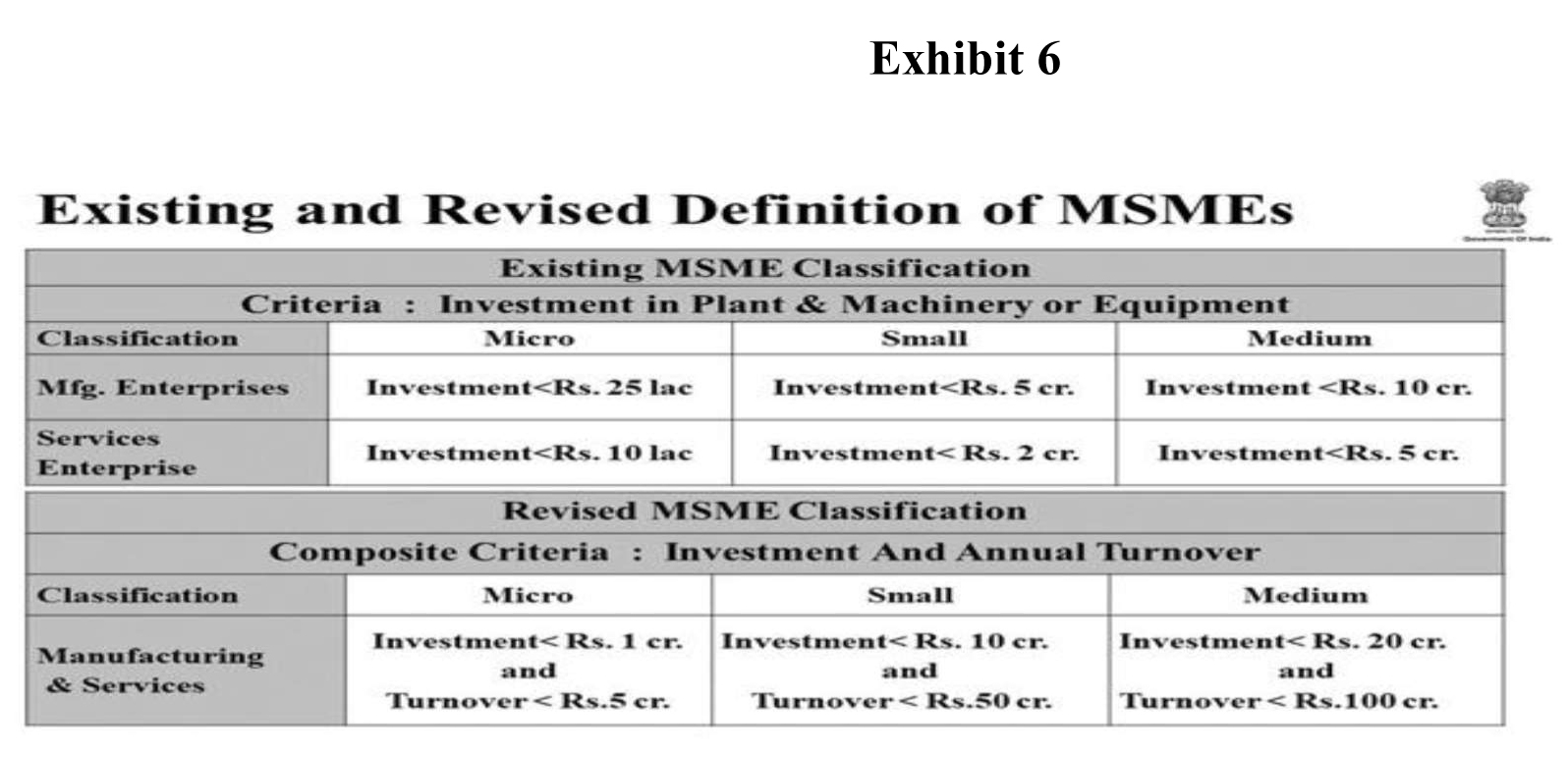
Source: The Economic Times
By enhancing the investment limits and including of turnover in the new definition of micro, small and medium enterprises, foray of more business organisations in the following areas may be observed in near future:
1. Telecommunications
- Domestic manufacturing of low-cost mobile phones, handsets, and devices;
- Manufacturing of telecom networking equipment, including routers and switches;
- Manufacture of base transceiver station equipment;
- Mobile customer data analytics – services oriented toward analytical solutions; and
- Development of value-added services.
2. Healthcare
- Manufacturing of personal protective equipment (PPE) and face masks, as the COVID-19 pandemic has fundamentally changed social behavior, public health and hospital needs, and created new demand;
- Manufacturing of low-cost medical devices, and medical accessories such as surgical gloves, scrubs, and syringes;
- Low-cost surgical procedures to reduce the cost of healthcare;
- Telemedicine; and
- Diagnostic labs.
3. Electronics
- Domestic manufacturing of low-cost consumer electronics, consumer durables;
- Nano-electronics and microelectronics;
- Electronic Systems Design and Manufacturing including semiconductor design, electronic components design and hi-tech manufacturing under India’s ‘National Electronics Mission; and
- Strategic electronics, as the government is keen on encouraging the domestic manufacturing of products needed by the security forces.
Other areas that may offer more opportunities for MSMEs due to the above mentioned revision in the criteria of investments in plant and machinery and turnover include information technology, pharmaceutical, chemical, automotive, renewable, gems and jewellery, textile, and food and agriculture.
Conclusion
MSME sector has been the backbone of the Indian economy. Apart from various schemes offered by the Government of India to strengthen the sector, the following key initiatives under unique and innovative ‘Atmanirbhar Bharat’ approach, i.e. Rs3 Lakh Crores Collateral-free Automatic loans for businesses, including MSMEs due to the menace of COVID 19, to provide additional funding in order to meet built up operational liabilities, procure raw materials and restarting of business; Allocation of Rs.20,000 Crores Subordinate Debt for stressed MSMEs. Under this arrangement, equity assistance would be provided to the stressed MSMEs; Government of India will facilitate provision of Rs.20,000 Crore as subordinate debt; MSMEs which are functioning and currently having non-performing assets (NPAs) or stressed will be eligible to seek assistance under this arrangement; Government of India will provide a support of Rs.4000 Crore to CGTMSE; CGTMSE to provide partial Credit Guarantee support to banks; Promoters of the MSMEs will be provided debt by banks, which will then be infused by promoter as equity in the business unit. It is heartening to note that this initiative will benefit approximately two lakhs MSMEs across the country.
Another significant measure under ‘Atmanirbhar Bharat’ is Rs.50,000 Crore equity infusion for MSMEs through Fund of Funds in view of the fact that MSMEs witness acute paucity of equity. In this initiative, a Fund of Funds with corpus of Rs.10,000 Crores will be established to provide equity funding to MSMEs with growth potential and feasibility. In order to make this approach viable, Fund of Funds will be operated through a Mother Fund and few Daughter Funds. This initiative will assist the MSMEs substantially in expanding their business as well as capacity and foster MSMEs to get listed on main board of Stock Exchanges.
Further, as discussed above that MSME sector is poised for huge growth in view of the forecasted trends of micro, small and medium enteprises in terms of both numbers and activity-wise coupled with the prevailing schemes and initiatives announced under Atmanirbhar Bharat will pave the way for a gigantic growth of MSME sector in India.
References
- Chakarabartty Kuntal (2016). “Contribution of MSMEs with Reference to Entrepreneurship Development and Employment Generation in North-East India: A Critical Evaluation”, Social Science Spectrum, Vol. 2, No. 3, Accessed from www.socialspectrum.in
- Sayeda Samin (2020). “Tracing the trajectory of the evolving MSME sector: Here’s what they need from a reliable financial partner”, Economic Times, Accessed from https://economictimes.indiatimes.com/small-biz/sme-sector/tracing-the-trajectory-of-the-evolving-msme-sector-heres-what-they-need-from-a-reliable-financial-partner/articleshow/73044715.cms?from=mdr
- Gopalakrishna Gaonkar M (2018). “Role of MSMEs in Promoting Entrepeurship in India”, Pune Research World, Vol.2, Issue 1, Accessed from http://puneresearch.com/media/data/issues/5ac99ed373899.pdf
- Banerjee Chandarjit (2020). “Redefining MSMEs will give the sector a boost”, Business Line, Accessed from https://www.thehindubusinessline.com/opinion/redefining-msmes-will-give-the-sector-a-boost/article30505802.ece
- “Registration of Micro, Small and Medium Enterprises (MSMEs) in India (Udyog Aadhaar Memorandum)”, Office of Development Commissioner M/o Micro, Small and Medium Enterprises Government of India, Accessed from http://www.dcmsme.gov.in/uam_publication_2015-2018.pdf
